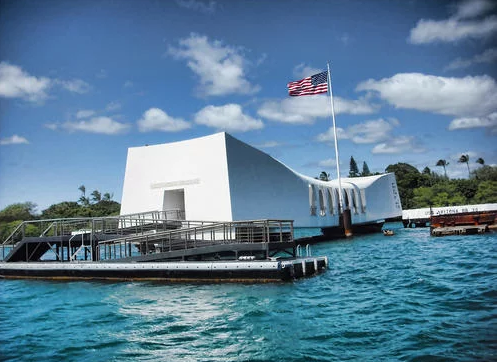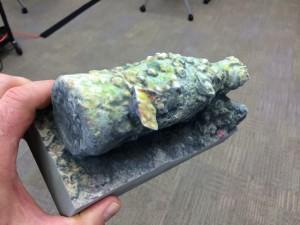 Today marks the 73rd anniversary of the day that the Japanese bombed Pearl Harbor, forever changing thousands of lives, while forcing the United States to enter World War II. As Franklin Delano Roosevelt proclaimed, as he asked for a Declaration of War, it was ‘A Date Which Will Live in Infamy’.
Today marks the 73rd anniversary of the day that the Japanese bombed Pearl Harbor, forever changing thousands of lives, while forcing the United States to enter World War II. As Franklin Delano Roosevelt proclaimed, as he asked for a Declaration of War, it was ‘A Date Which Will Live in Infamy’.
My uncle, Albert Matthews, who passed away earlier this year, was stationed in Pearl Harbor as the Japanese dive bombers launched their surprise attack. He was a fortunate survivor, unlike the 2,403 Americans killed on that tragic day. Every year on December 7th, he would tell his story and we would all listen, wondering what it must have felt like to actually have experienced what he had decades ago.
As the handful of Pearl Harbor survivors remaining dwindle with time, soon we will no longer be able to listen to their first-hand accounts of that life-altering day. Luckily the history will always be on display for the public to see, at the spot in which it all took place 73 years ago, Pearl Harbor. In 1962, the USS Arizona was designated as a national shrine, and is visited by tens of thousands of people annually. Just like those who were present on December 7, 1941, the USS Arizona also is aging, and may one day no longer be with us. The steel-framed ship has been submerged in salt water for 73 years, and we all know what salt will to steel.
Thanks to new technologies, such as 3D scanning, researchers and photographers are working to help preserve this national shrine, ensuring that it will stand for decades to come. Executives and technologists from Autodesk have set out on a mission to scan the USS Arizona, both above and below the surface of the water. While they are using technologies such as LiDAR and SONAR, one of the other more interesting technologies is that 3D modeling, via photogrammetry, as well as 3D printing.
The team at Autodesk is relying heavily on their Recap software which allows for numerous photographs to be taken and then stitched together using powerful computational algorithms, to form comprehensive 3D models of sections of the battleship.
“We take a series of photos around an object, and the program calculates the camera’s position in space by looking at unique little identifiers on the object surface,” explained Shaan Hurley, a technologist at Autodesk. “You end up with a textured 3D representation of the object.”
3D modelling gives an entirely new perspective to researchers, architects, and historians, while allowing them to take things even further by printing the models out on a 3D printer, placing the artifacts directly into their hands.
While the scans will allow the Park Service to detect changes and decay within the structure of the shrine, there are other applications for the data collected as well. This includes producing models for virtual tourism, allowing anyone to put themselves right in the middle of where this tragedy took place. Additionally, as mentioned earlier this year, those interested will be able to 3D print near-exact replicas of certain artifacts from the site. Pete Kelsey, a strategic projects executive at Autodesk told GCN.com that he expects to have models for such applications available sometime next year.
It’s really incredible what 3D scanning and printing are making possible, preserving our past, while presenting us all with a promising future. Check out the video below of my Uncle Al describing Pearl Harbor 73 years ago, to the day, followed by a video depicting the process of 3D modeling the USS Arizona under water. Let us know your thoughts on this story in the 3D Modeling Pearl Harbor forum thread on 3DPB.com.
Subscribe to Our Email Newsletter
Stay up-to-date on all the latest news from the 3D printing industry and receive information and offers from third party vendors.
You May Also Like
NSF Awards Kentucky $1M for Advanced Manufacturing
The National Science Foundation has awarded a $1 million grant to the University of Louisville for the Advancing Manufacturing and Building Construction Technologies (NSF AMT) project. This initiative is part...
3D Printing News Briefs, May 11, 2024: 3D Printed Stent, Tower, Sculptures, & More
We’re starting off with medical research in today’s 3D Printing News Briefs, as researchers in Korea used CT images and 3D printing to fabricate an educational simulator for a mastoidectomy....
3D Printing Unpeeled: Wind Turbines, Probiotics and Lenses
TPI Composites, ORNL and Ingersoll Rand are working to make wind turbine tooling segments that can be 18.3 meters long. These elements also include resistive wires that help keep the...
Tethon 3D Releases Cost-effective Bioprinter
Tethon 3D, known for its ceramic-loaded DLP materials, custom resins, and DLP 3D printers, has recently released a bioprinter. Vat polymerization printers like DLP systems have been widely used by...


































